“Placed on this planet since yesterday, and only for a day, we can only hope to glimpse the knowledge that we will probably never attain.”
-Horace-Bénédict de Saussure, 1796
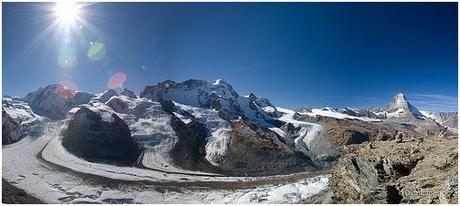
Dateline: Mount Pilates, Switzerland
I’ve penned a few books that have been placed in the category of “wilderness travel.” But perhaps the first to stock this shelf was the eighteenth-century mountaineer Horace-Bénédict de Saussure, who wrote in his opus, Voyages dans les Alpes, that the chamois hunters of the Alps experienced a certain delight in their dangerous profession: “It is these very dangers, this alternation of hope and fear, the continual agitation kept alive by these sensations in his heart, which excite the huntsman, just as they animate the gambler, the warrior, the sailor and, even to a certain point, the naturalist among the Alps whose life resembles closely, in some respects, that of the chamois hunter.” As someone who has spent some time exploring wild rivers in remote corners and who holds the distinction of having capsized on six continents, I know this notion–that life is more intensely lived the closer one gets to its extinction. We never feel so alive as when we have nearly died.
Upward we creep at six miles an hour on a track built on a wall of granite blocks. We move like an underwater runner from the dark and spiry pine forests of the base past the timberline to the snow-dusted, rocky outcroppings of the seven-thousand-foot shoulder. The continual agitation, the swaying rhythm of hope and fear, fear and hope notwithstanding, somehow it doesn’t seem right to climb this high without any panting or pain. But travel by train does allow a feeling of something beyond the merely functional or utilitarian.
The mountain, however absurd it seems, is named for Pontius Pilate, the Roman governor of Judea who presided over the crucifixion of Jesus Christ and, according to tradition, later committed suicide in prison rather than face the prospect of death at the hands of Emperor Tiberius. Legend has it that each time the Romans tried to dispose of Pilate’s body, weighed down with stones, in various rivers, including the Tiber and the Rhône, fierce storms swept in and wouldn’t stop until the corpse was retrieved. The Romans considered the Alps inhospitable, desolate, hostile–ocris, arduus, horridus. The Roman poet and philosopher Titus Lucretius Carus, about a half century before Christ, called the Alps the waste places of the world, where nature had swept its rubbish. And so such seemed the place the Romans might rid themselves of this curse at last.
They carried the body up an isolated mountain in Switzerland, a peak then known as Frakmont, and left Pilate’s remains in a dark lake near the top. For good measure, his wife, Procla, was tossed into a nearby pond.
But Pilate still caused trouble, and storms still blew, so Lucerne authorities banned the ascent of the mountain. When six clerics tried to climb the hill unaided in 1387, they were imprisoned. There was a belief that every Good Friday, Pilate’s tormented spirit would float to the surface of the lake in an attempt to wash his hands of Jesus’s blood. But it’s hard to validate. Supposedly, all those who saw the specter died within a year.
Stories transcend history, and though dozens of mountain places in the Middle Ages boasted of the burial plot of the man behind the crucifixion, the claim of this one, with its evocative tales, took.
It wasn’t until the sixteenth century that it was legal to climb the mountain’s shanks, and to this day locals like to blame Pilate for the violent storms that not uncommonly break over the area.
Queen Victoria took on the beleaguered spirit of Pontius Pilate and assorted dragons in the summer of 1868, ascending halfway up the mountain in a sedan chair, the rest on a pony brought from England. It was her first trip to the Alps. Still in mourning for Prince Albert, she was persuaded of the virtues of such an expedition by her doctors, who were concerned about her withdrawal from society. She knew of Albert’s love of Alpine scenery (he had brought her a pressed alpenrose from the slopes of Mount Rigi) and eventually conceded the therapeutic qualities of the scheme.
She traveled incognito, pretending to be the “Countess of Kent.” Arriving at the start of August, she settled into a pension in Lucerne and admired the vistas that were so much grander than anything on the isles. She wrote in her diary: “What am I to say of the glorious scenery of Switzerland; the view from this House which is very high is most wonderfully beautiful with the lake–Pilatus, the Righi etc. I can hardly believe my eyes when I look at it.”
Her little adventure helped bleach the long-held taboo and inspired her subjects in ever-increasing numbers to come “take the air” of this and other alps.
Once we dock in the gaping maw of the terminal station, I head out and step the palisade, the wind sharp and moaning. Guides, with a wink, say the sound is Pilate’s ghost as he wanders the slopes searching for a route to heaven. But the sensations of sound and wind do not dominate here; instead, it is sight.
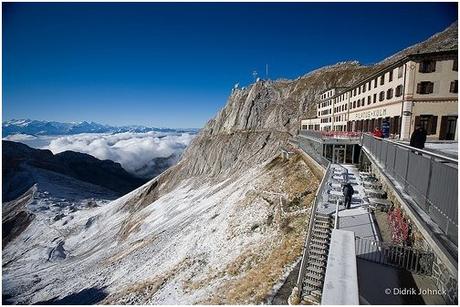
Seventy-three alpine summits and six lakes can be viewed from this vantage. Looking across a sea of clouds, I’m seized by a sober intoxication from the view of the marching mountains of the Bernese Oberland: the Eiger to the left, then the Mönch in the middle, and the Jungfrau on the right.
Legend holds that the Mönch (“Monk”) peak is protecting the Jungfrau (“Virgin”) from the nearby Eiger (“Ogre”). But to me, here at this viewpoint, it looks to be the other way around. “It is a good name, Jungfrau–Virgin. Nothing could be whiter; nothing could be purer; nothing could be saintlier of aspect,” wrote Mark Twain on his 1891 visit. But when I read this uncharacteristically sincere sentiment, all I can think of is Mae West’s line:
“I used to be Snow White, but I drifted.”
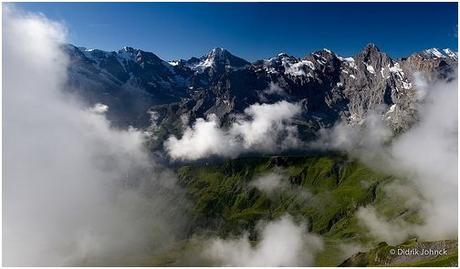
There is, not surprisingly, a less romantic version. Jungfrau likely got its name because a convent once owned pastures at the foot of the mountain. Eiger–famous for its killer north face–could derive from the Latin acer, meaning sharp, or the old German ger, meaning a spear or javelin. And Mönch? Chances are its lower pastures were owned by monks.
Legends notwithstanding, this is an empirical domain, and the feelings evoked are powerful, at least to me at this moment. My insides seem to be filling with a froth of excitement and awe, as a punctured raft fills with cold river water. But such regard was not always accorded here. For generations, the mountains signified only the deformed and execrable, thinly soiled, steeply sloped, bad for farming, disease ridden, ordeals to cross, the lairs of energetic demons and trolls. Adam of Usk was so petrified when he crossed Switzerland’s St. Gotthard Pass in 1402 he had to be blindfolded, and travelers after him would often close the carriage curtains to avoid the dreadful scenes of the Alps. Anything could happen in this icy semicircle of teeth that bit off Italy from the rest of Europe. Not only were the Alps scary, but they also were ugly, blemishes on the terrestrial globe, and people of good taste sought to avoid them.

The classical notions of beauty called for purity, order, restraint, regularity, proportion–perfection. The Alps were disordered, irregular, chaotic, and bad-mannered. The seventeenth-century diarist John Evelyn thought them “horrid and fearful.” (His sentiments were published posthumously when discovered in 1817 in a laundry basket.) The early eighteenth-century essayist Joseph Addison wrote to his friend Edward Wortley, “I am just now arriv’d at Geneva by a very troublesome Journey over the Alpes, where I have bin for some days together shivering among the Eternal Snows.” The monk John de Bremble, one of the earliest English travelers to the mountains of Switzerland, was so horrified by his experience crossing the Great St. Bernard Pass that he prayed, “Lord restore me to my brethren, that I may tell them not to come to this place of torment.” Bishop Berkeley, crossing the Alps in 1714, carped, “Every object that here presents itself is excessively miserable.”
In 1723, a Swiss fellow of the Royal Society, Johann Jacob Scheuchzer, penned a famous dracopoeia, a detailed description of Alpine dragons. (He even saw one.) He also discovered near Brig a super intelligent community, most of whose members shared the surname Supersaxo, who were fluent in German, French, Italian, and Latin, and descended from a sixteenth-century Italian count who had sired twelve sons and eleven daughters. And he believed that certain chamois possessed a stone in their bellies that rendered them immune to bullets.
What may be the first travel brochure for Switzerland, Les Délices de la Suisse, published by Abraham Ruchat in 1714, promoted the tidiness of the towns and the happiness and health of the cows but was dismayed with the “eternal snows” of the high Alps. “These great excrescences of the earth,” it declared, “to outward appearance have neither use nor comeliness.” Others cited the Alps as nature’s shames and ills, as boils, blisters, warts, and wens, and even called the peaks the “Devil’s arse” and the steep valleys “Nature’s pudenda.”
A German traveler in 1785 wrote, “What struck me most in Switzerland among the curiosities of nature were those horrid structure the Alps.” Sir Leslie Stephen, the pioneering mountaineer and biographer, and father of novelist Virginia Woolf and painter Vanessa Bell, wrote in his 1871 book, The Playground of Europe: “Before the turning-point of the eighteenth century, a civilized being might, if he pleased, regard the Alps with unmitigated horror.” And indeed in 1791 William Gilpin noted that “the generality of people” found wilderness dislikable. “There are few,” he wrote, “who do not prefer the busy scenes of cultivation to the greatest of nature’s rough productions.” Mountains were things to avoid, or, if one were a merchant, soldier, or pilgrim, to go around. Mountains, as a whole, were anathema.
So, how did this mindset change? Some of the shift, perhaps, had to do with the palpable deterioration of the cities of the Europe, especially smoggy, coal-blackened London, with its rising fatigue and social atomization. The success of the agricultural revolution, with its crop rotation and protective enclosures, created a steep upward curve in food production and in turn population. As more people flocked from the fields to the economic opportunities that cities promised, sewage got worse, crime increased, urban blight spread, and faith in a higher power that looked after those in need faded.
By 1847, England was the first country in the world where more people lived in cities than in the countryside, and more were employed in industry than in agriculture. From this claustrophobic urban cesspit, the cholera epidemic broke in 1832, killing fifty thousand people. Influenza, measles, scarlet fever, and diphtheria became epidemic.
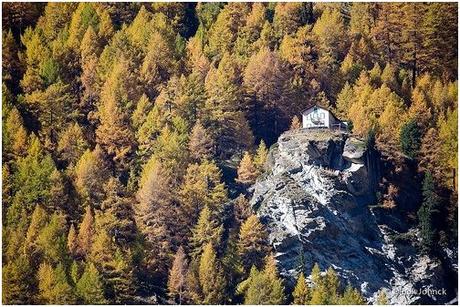
Tuberculosis was spread effectively by the perfect storm of the dense population, the damp climate, and the concentration of smoke from factories and homes. By the middle of the nineteenth century, tuberculosis accounted for one death in six in England.
In the wake of this corrosive wave there evolved the romantic notion of the virtues of the simple, clean, and healthy life in nature; the bucolic verve among the mountains that the Swiss seemed to exhibit found special appeal. It was, however, the industrial revolution that led to vastly improved means of transport and to a chattering class with disposable income. Those developments allowed and inspired travel to places such as Switzerland, where the high mountains and contented people set the minds wandering, and perhaps got rid of that nasty cough.
Alongside this came a renewal in a biblical belief that mountains, in all their horror, were manifestations of God’s work. Poets and artists called the feelings they felt when experiencing the Alps sublime. Among these was the Swiss natural scientist Albrecht von Haller, who, after exploring the Bernese Oberland, published in 1729 a poem called Die Alpen (The Alps) that contrasted the redoubtable Alpine peasant’s natural way of life with the civilized lifestyle of the metropolitan elite and concluded the mountain life was better. “Luck is much too poor to improve his well-being,” he rhapsodized about the Swiss peasant.
In 1739, Thomas Gray took the Grand Tour, crossed the Alps, kept a journal, and wrote letters in which he used the adjectives “romantic” and “poetic” and the phrases “a sacred terror” and “a severe delight.”
With these words he planted the seeds that grew a movement. “Magnificent rudeness and steep precipices. . . . You can here meet with all the beauties so savage and horrid a place can present you with; Rocks of various and uncouth figures, Cascades pouring down from an immense height out of hanging groves of Pine-Trees, & the solemn Sound of the Stream that roars below, all concur to form one of the most poetical scenes imaginable.”
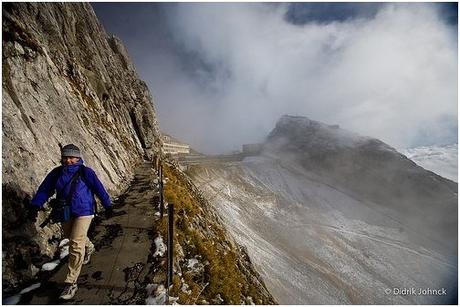
Mountain landscapes were not conventionally regarded as worthy of regard in Western literature from Virgil through Dante on down to Shakespeare and Milton. It was the rock star Romantic poets who changed this. William Wordsworth, who called himself “an Islander by birth, a Mountaineer by habit,” made a journey of three thousand miles on his first visit to the Alps, more than half on foot. Although the habit of pedestrian travel for pleasure in the mountains was becoming agreeable to many of the Swiss, walking for the rest of the Western world was the curse of the poor. Wordsworth and his friend Robert Jones followed the course of the Rhône and crossed the Simplon Pass into Italy. The result of the trip was a long poem, “Descriptive Sketches Taken during a Pedestrian Tour among the Alps,” in which he shares his enthusiasm for a new type of therapy:
He holds with God himself communion high
There where the peal of swelling torrents fills
The sky-roofed temple of eternal hills;
Or when, upon the mountain’s silent brow
Reclined, he sees, above him and below,
Bright stars of ice and azure fields of snow. . . .
But while Wordsworth’s poetry provoked a desire to see the Alps, politics stepped in the way. Napoleon seized the greater part of what today is Switzerland in 1798, creating the “Helvetic Republic,” and few of the English were inclined to visit. But after in 1815 Napoleon was defeated at Waterloo and the Congress of Vienna guaranteed neutrality for Switzerland, the poets came once more, and were no less awed.
George Gordon Byron’s take on The Sublime was that it was something distinct from the beauty so often extolled in English gardens: it involved violence and terror mingled with exultation. “Are not the mountains, waves and skies a part of me and of my soul, as I of them?” The Alps were “palaces of Nature,” that “throned Eternity in icy halls of cold sublimity.” They were the greatest manifestations on earth of the power that had created them. “All that expands the spirit, yet appalls, gather around these summits.”
Percy Bysshe Shelley’s tributes to grand nature were similar: “terrible, strange, sublime, awful.” After experiencing the Alps, he wrote:
The everlasting universe of things
Flows through the mind, and rolls its rapid waves,
Now dark–now glittering–now reflecting gloom–
Now lending splendour, where from secret springs
The source of human thought its tribute brings. . . .
The idols of pattern, regularity, symmetry, restraint, proportion, and vocabulary were broken down and replaced by ideals of diversity, variety, irregularity, indefiniteness, and vastness, and the feelings they provoked. It was something on the other side of thought and language. The flocking of the Victorians to the Swiss Alps was not about growing crops, grazing animals, or extracting minerals. It was about observing, feeling, and articulating a personal response. “To me / High mountains are a feeling,” declared the protagonist in Lord Byron’s narrative poem “Childe Harold’s Pilgrimage.” Switzerland became a literary topography as much as a geographical designation. Poets and other artists provided a vocabulary of these landscapes, and the seekers came.

